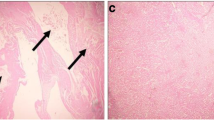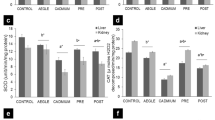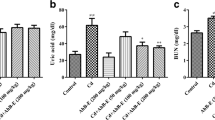Abstract
Cadmium (Cd), a non-redox metal, has been described as an environmental toxicant that poses a great threat to human health. Therefore, this study aimed to appraise the mitigating potential of the aqueous extract of Bridelia ferruginea (Bf) stem bark against hepato-renal toxicity in Cd-exposed Wistar rats. Thirty (30) adult male Wistar rats (weight 150–200 g) were randomly grouped into five (5) groups of six (6) rats each (n = 6), and experimental rats received a single treatment of cadmium chloride (CdCl2; 30 mg/kg body weight (bw)). Cd-exposed rats were administered 50, 100, and 200 mg/kg bw aqueous extract of Bf stem bark for 14 days. Cd exposure caused hepato-renal toxicity in the untreated control as revealed by a significant (p < 0.05) increase in the serum liver function markers (i.e., AST, ALT, and ALP) as well as a marked (p < 0.05) decrease in hepatic antioxidant enzymes. A similar effect was also noticed in the renal function biomarkers (i.e., creatinine and urea) and its antioxidant enzymes. However, Cd-exposed groups–administered aqueous extract of Bf stem bark revealed a significant (p < 0.05) decrease in serum activities of AST, ALP, and ALT, as well as a significant (p > 0.05) difference in TP level compared to Cd-induced hepato-renal toxicity untreated and normal control. Similarly, hepatic and renal antioxidant parameters (SOD, CAT, and GSH), TP, serum lipid profile, urea, and creatinine were significantly (p < 0.05) improved among the groups-administered aqueous extract of Bf stem bark compared to Cd-induced hepato-renal toxicity untreated and normal control. The renal and hepatic Cd concentrations of groups administered aqueous extract of Bf stem bark significant (p < 0.05) decrease compared to Cd-induced hepato-renal toxicity untreated and normal control. Likewise, histological examinations of kidney and liver tissues of the groups administered aqueous extract of Bf stem bark revealed restoration of normal architecture. Therefore, aqueous extract of Bf stem bark could be suggested to be hepatoprotective and renoprotective in Cd toxicity.




Similar content being viewed by others
References
Adesina AJ, Akomolafe FS (2014) “Full length research paper nutritional and anti-nutritional composition of Bridelia ferruginea Benth (Euphorbiaceae) stem bark sample. Int J Sci Res Knowl 2(2):92–104
Afolabi OB, Oloyede OI, Agunbiade SO (2018) Inhibitory potentials of phenolic-rich extracts from Bridelia ferruginea on two key carbohydrate-metabolizing enzymes and Fe2+-induced pancreatic oxidative stress. J Integr Med 16(3):192–198
Agra MF, Freitas PF, Barbosa-Filho JM (2007) Synopsis of the plants known as medicinal and poisonous in northeast of Brazil. Rev Bras Farmacogn 17:114–140
Andjelkovic M, Buha DA, Antonijevic E et al (2019) Toxic effect of acute cadmium and lead exposure in rat blood, liver, and kidney. Int J Environ Res Public Health 16(2):274
Arisawa K, Uemura H, Hiyoshi M et al (2007) Cause-specific mortality and cancer incidence rates in relation to urinary β2-microglobulin: 23-year follow-up study in a cadmium-polluted area. Toxicol Lett 173(3):168–174
Association of Official Analytical Chemists (AOAC) (1995) Official methods of analysis. Washington (DC), USA
Benavides MP, Gallego SM, Tomaro ML (2005) Cadmium toxicity in plants. Braz J Plant Physiol 17(1):21–34
Beyersmann D, Hartwig A (2008) Carcinogenic metal compounds: recent insight into molecular and cellular mechanisms. Arch Toxicol 82(8):493–512
Branca JJ, Morucci G, Pacini A (2018) Cadmium-induced neurotoxicity: still much ado. Neural Regen Res 13(11):1879
Brewer HB (2011) Clinical review: the evolving role of HDL in the treatment of high-risk patients with cardiovascular disease. J Clin Endocrinol Metab 96:1246–1257
Cuypers A, Plusquin M, Remans T et al (2010) Cadmium stress: an oxidative challenge. Biometals 23(5):927–940
Deng Y, Zhang Y, Lemos B, Ren H (2017) Tissue accumulation of microplastics in mice and biomarker responses suggest widespread health risks of exposure’. Sci Rep 7:46687
Donadio C, Lucchesi A, Tramonti G, Bianchi C (1997) Creatinine clearance predicted from body cells mass is a good indicator of renal function. Kidney Int 52:166–168
Ekanem JT, Kolawole OM, Abbah OC (2008) Trypanocidal potential of methanolic extracts of Bridelia ferruginea benth bark in Rattus novergicus. Afr J Biochem Res 2(2):045–050
El-Boshy M, Ashshi A, Gaith M et al (2017) Studies on the protective effect of the artichoke (Cynara scolymus) leaf extract against cadmium toxicity-induced oxidative stress, hepatorenal damage, and immunosuppressive and hematological disorders in rats. Environ Sci Pollut Res 24(13):12372–12383
Ellman GL (1959) Tissue sulfhydryl groups. Arch Biochem Biophys 82(1):70–77
Erboga M, Kanter M (2016) Effect of cadmium on trophoblast cell proliferation and apoptosis in different gestation periods of rat placenta. Biol Trace Elem Res 169(2):285–293
Ercal N, Gurer-Orhan H, Aykin-Burns N (2001) Toxic metals and oxidative stress part I: mechanisms involved in metal-induced oxidative damage. Curr Top Med Chem 1(6):529–539
Gabr SA, Alghadir AH, Ghoniem GA (2019) Biological activities of ginger against cadmium-induced renal toxicity. Saudi J Biol Sci 26(2):382–389
Godt J, Scheidig F, Grosse-Siestrup C (2006) The toxicity of cadmium and resulting hazards for human health. J Occup Med Toxicol 1(1):1–6
Guirlet E, Das K (2012) Cadmium toxicokinetics and bioaccumulation in turtles: trophic exposure of Trachemys scripta elegans. Ecotoxicol 21(1):18–26
Hassoun EA, Stohs SJ (1996) Cadmium induced production of superoxide anion and nitric oxide. DNA single strand breaks and lactate dehydrogenase leakage in J774A1 cell cultures. Toxicol 112 (3):219–226
Huang CT, Chen ML, Huang LL, Mao IF (2002) Uric acid and urea in human sweat. Chinese J Physiol 45(3):109–116
Ige SF, Akhigbe RE (2013) Common onion (Allium cepa) extract reverses cadmium-induced organ toxicity and dyslipidemia via redox alteration in rats. Pathophysiology 20(4):269–274
Jaishankar M, Tseten T, Anbalagan N et al (2014) Toxicity, mechanism and health effects of some heavy metals. Inter Toxicol 7(2):60
Jaiyesimi KF, Agunbiade OS, Ajiboye BO, Afolabi OB (2020) Polyphenolic-rich extracts of Andrographis paniculata mitigate hyperglycemia via attenuating β-cell dysfunction, pro-inflammatory cytokines and oxidative stress in alloxan-induced diabetic Wistar albino rat. J Diabetes Metab Disord 19(2):1543–1556
Kar I, Patra AK (2021) Tissue bioaccumulation and toxicopathological effects of cadmium and its dietary amelioration in poultry—a review. Biol Trace Elem Res 6:1–23
Kefaloyianni E, Gourgou E, Ferle V et al (2005) “Acute thermal stress and various heavy metals induce tissue-specific pro- or anti-apoptotic events via the p38-MAPK signal transduction pathway in Mytilus galloprovincialis (Lam.). J Exp Biol 208:4427–4436
Knepper MA, Roch-Ramel F (1987) Pathways of urea transport in the mammalian kidney. Kidney Int 31(2):629–633
Kojima M, Masui T, Nemoto K, Degawa M (2004) Lead nitrate-induced development of hypercholesterolemia in rats: sterol-independent gene regulation of hepatic enzymes responsible for cholesterol homeostasis. Toxicol Lett 154(1–2):35–44
Laskow DA, Curtis JJ, Luke RG et al (1990) Cyclosporine-induced changes in glomerular filtration rate and urea excretion. Am J Med 88(5):497–502
Levey AS, Bosch JP, Lewis JB et al (1999) A more accurate method to estimate glomerular filtration rate from serum creatinine: a new prediction equation. Ann Intern Med 130(6):461–470
Liang Y, Lei L, Nilsson J et al (2012) Renal function after reduction in cadmium exposure: an 8-year follow-up of residents in cadmium-polluted areas. Environ Health Perspect 120(2):223–228
Liu L, Liu Y, Cheng X, Qiao X (2021) The alleviative effects of quercetin on cadmium-induced necroptosis via inhibition ROS/iNOS/NF-κB pathway in the chicken brain. Biol Trace Elem Res 199(4):1584–1594
Malhotra P, Gill RK, Saksena S, Alrefai WA (2020) Disturbances in cholesterol homeostasis and non-alcoholic fatty liver diseases. Front Med 7:467
Mantur VS, Somannavarib MS, Yendigeri S et al (2014) Ameliorating effect of black tea extract on cadmium chloride-induced alteration of serum lipid profile and liver histopathology in rats. Indian J Physiol Pharmacol 58(2):2
Misra HP, Fridovich I (1972) The role of superoxide anion in the autoxidation of epinephrine and a simple assay for superoxide dismutase. J Biol Chem 247(10):3170–3175
Morakinyo AO, Oloyo AK, Raji Y et al (2008) “Effects of aqueous extract of garlic (Allium sativum) on testicular functions in the rat. Nigerian J Health Biomed Sci 7(2):26–30
Morales AI, Vicente-Sanchez C, Sandoval JS et al (2006) Protective effect of quercetin on experimental chronic cadmium nephrotoxicity in rats is based on its antioxidant properties. Food Chem Toxicol 44(12):2092–2100
Musa S, Çelik İ (2020) Determination of hepatoprotective and antioxidant role of thyme (origanum onites l.) infusion against ethyl alcohol induced oxidative stress in rats. Bitlis Eren Uni J Sci Tech 10(2)
Ndukwe KC, Okeke IN, Lamikanra A et al (2005) Antibacterial activity of aqueous extracts of selected chewing sticks. J Contemp Dent Pract 6(3):86–94
Ness GC, Gertz KR, Holland RC (2001) Regulation of hepatic lanosterol 14-demethylase gene expression by dietary cholesterol and cholesterol-lowering agents. Arch Biochem Biophys 395:233–238
Obafemi TO, Onasanya A, Adeoye A et al (2019) Protective effect of methanolic and flavonoid-rich leaf extracts of Synsepalum dulcificum (Danielli) on lead-acetate-induced toxicity in Wistar albino rats. J Appl Pharm Sci 9(5):65–72
Ognjanovic BI, Markovic SD, Pavlovic SZ et al (2008) “Effect of chronic cadmium exposure on antioxidant defense system in some tissues of rats: protective effect of selenium. Physiol Res 57(3):403–411
Olajide OA, Makinde JM, Awe SO (1999) Effect of aqueous extract of Bridelia ferruginea stem bark corrageenan-induced Oedema and granuloma tissue formation on rats and mice. J Ethnopharmacol 66(1):113–117
Olajide OA, Makinde JM, Okpako DT, Awe SO (2000) Studies on the anti-inflammatory and related pharmacological properties of the aqueous extract of Bridelia ferruginea stem bark. J Ethnopharmacol 71(1–2):153–160
Oloyede OI, Babalola SO (2012) In-vitro Antioxidant activity of ethanolic extract of Bridelia ferruginea. J Acad Res Int 2(3):2223–9944
Ozer J, Ratner M, Shaw M et al (2008) The current state of serum biomarkers of hepatotoxicity. Toxicol 245(3):194–205
Pham TA (2017) Validation of the salivary urea and creatinine tests as screening methods of chronic kidney disease in Vietnamese patients. Acta Odontol Scand 75(8):551–556
Pham-Huy NL, He H, Pham-Huy C (2008) “Green tea and health. An Overview. J Food Agric Environ 6:6–13
Podgórska A, Burian M, Rychter AM et al (2017) Short-term ammonium supply induces cellular defence to prevent oxidative stress in Arabidopsis leaves. Physiol Plant 160(1):65–83
Pratush A, Kumar A, Hu Z (2018) Adverse effect of heavy metals (As, Pb, Hg, and Cr) on health and their bioremediation strategies: a review. Inter Microbiol 21(3):97–106
Rani A, Kumar A, Lal A, Pant M (2014) Cellular mechanisms of cadmium-induced toxicity: a review. Int J Environ Health Res 24(4):378–399
Rech M, To L, Tovbin A et al (2014) Heavy metal in the intensive care unit: a review of current literature on trace element supplementation in critically ill patients. Nutr Clin Pract 29(1):78–89
Reimann C, de Caritat P (2005) Distinguishing between natural and anthropogenic sources for elements in the environment: regional geochemical surveys versus enrichment factors. Sci Total Environ 337(1):91–107
Reitman S, Frankel S (1957) A colorimetric method for the determination of serum glutamic oxalacetic and glutamic pyruvic transaminases. Am J Clin Pathol 28(1):56–63
Renugadevi J, Prabu SM (2010) Quercetin protects against oxidative stress-related renal dysfunction by cadmium in rats. Exp Toxicol Pathol 62(5):471–481
Salama SA, Arab HH, Hassan MH, Maghrabi IA (2019) Cadmium-induced hepatocellular injury: modulatory effects of γ-glutamyl cysteine on the biomarkers of inflammation, DNA damage, and apoptotic cell death. J Trace Elem Med Biol 52:74–82
Satarug S, Garrett SH, Sens MA, Sens DA (2010) Cadmium, environmental exposure, and health outcomes. Environ Health Perspect 118(2):182–190
Seif MM, Madboli AN, Marrez DA, Aboulthana WM (2019) Hepato-renal protective effects of Egyptian purslane extract against experimental cadmium toxicity in rats with special emphasis on the functional and histopathological changes. Toxicol Rep 6:625–631
Shahid M, Dumat C, Khalid S et al (2016) Cadmium bioavailability, uptake, toxicity and detoxification in soil-plant system. Rev Environ Contam Toxicol 241:73–137
Sharma B, Singh S, Siddiqi NJ (2014) Biomedical implications of heavy metals induced imbalances in redox systems. BioMed Res Inter
Shukla GS, Kumar RL (2009) The present status of biological effects of toxic metals in the environment: lead, cadmium, and manganese. Can J Physiol Pharmacol 62(8):1015–1031
Sinha AK (1972) Colorimetric assay of catalase. Anal Biochem 47(2):389–394
Srilaxmi P, Sareddy GR, Setty OH, Babu PP (2010) Protective efficacy of natansnin, a dibenzoyl glycoside from Salvinia natans against CCl4 induced oxidative stress and cellular degeneration in rat liver. BMC Pharmacol 10(1):1–3
Stankovic S, Kalaba P, Stankovic AR (2014) Biota as toxic metal indicators. Environ Chem Lett 12(1):63–84
Stohs SJ, Bagchi D, Hassoun E, Bagchi M (2001) Oxidative mechanisms in the toxicity of chromium and cadmium ions. J Environ Pathol Toxicol Oncol 20(2)
Szaleczky E, Prechl J, Feher J, Somogyi A (1999) Alterations in enzymatic antioxidant defence in diabetes mellitus− a rational approach. Postgrad Med J 75(879):13–17
Talla E, Djamen D, Djouldé DR (2002) Antimicrobial activity of Bridelia ferruginea leaves extracts. Fitoterapia 73(4):343–345
Thévenod F (2010) Catch me if you can! Novel aspects of cadmium transport in mammalian cells. Biometals 23(5):857–875
Vinodhini R, Narayanan M (2008) Bioaccumulation of heavy metals in organs of fresh water fish Cyprinus carpio (Common carp). Int J Environ Sci Technol 5(2):179–182
Walser M, Bodenlos LJ (1959) Urea metabolism in man. J Clin Invest 38(9):1617–1626
Wang S, Shi X (2001) Molecular mechanisms of metal toxicity and carcinogenesis. Mol Cell Biochem 222(1):3–9
Webster AC, Nagler EV, Morton RL, Masson P (2017) Chronic kidney disease. Lancet 389(10075):1238–1252
Yang B, Bankir L (2005) Urea and urine concentrating ability: new insights from studies in mice. Am J Physiol Renal Physiol 288(5):F881–F896
Zhang J, Zheng S, Wang S et al (2020a) Cadmium-induced oxidative stress promotes apoptosis and necrosis through the regulation of the miR-216a-PI3K/AKT axis in common carp lymphocytes and antagonized by selenium. Chemosphere 258:127341
Zhang Y, Yin H, Shao B et al (2020b) Antagonistic effect of VDR/CREB1 pathway on cadmium-induced apoptosis in porcine spleen. Ecotoxicol Environ Saf 209:111819
Zheng Y, Shi B, Ma M et al (2019) The novel relationship between Sirt3 and autophagy in myocardial ischemia–reperfusion. J Cell Physiol 234(5):5488–5495
Acknowledgements
The authors of this work hereby appreciate the Provost, College of Sciences, Afe Babalola University for his support and for creating a research-friendly environment for the success of this work.
Author information
Authors and Affiliations
Contributions
All authors contributed to the conception and design of the study. Supervision of the study by Omotade Ibidun Oloyede. material preparation, data collection, and analysis were performed by Olakunle Bamikole Afolabi, Oluwafemi Emmanuel Babatunde, Adegbolagun Grace Adegboro, and Damilola Oluwaseun Ogunkorode. The first draft of the manuscript was written by Oluwafemi Emmanuel Babatunde and Olakunle Bamikole Afolabi. All authors read and approved the final manuscript.
Corresponding author
Ethics declarations
Ethics approval
All animals received humane care with a strict compliance to the ethical guidelines issued according to the principles of laboratory animal care (LAC) of the National Society of Medical Research and in accordance with the principles of laboratory animal care.
Consent to participate
None.
Consent for publication
None.
Conflict of interest
The authors declare no competing interests.
Additional information
Publisher's Note
Springer Nature remains neutral with regard to jurisdictional claims in published maps and institutional affiliations.
Rights and permissions
Springer Nature or its licensor holds exclusive rights to this article under a publishing agreement with the author(s) or other rightsholder(s); author self-archiving of the accepted manuscript version of this article is solely governed by the terms of such publishing agreement and applicable law.
About this article
Cite this article
Oloyede, O.I., Afolabi, O.B., Babatunde, O.E. et al. Cytoprotective potential of the aqueous extract from Bridelia ferruginea stem bark against experimental cadmium-induced hepato-renal toxicity in Wistar rat. Comp Clin Pathol 31, 967–978 (2022). https://doi.org/10.1007/s00580-022-03399-1
Received:
Accepted:
Published:
Issue Date:
DOI: https://doi.org/10.1007/s00580-022-03399-1




